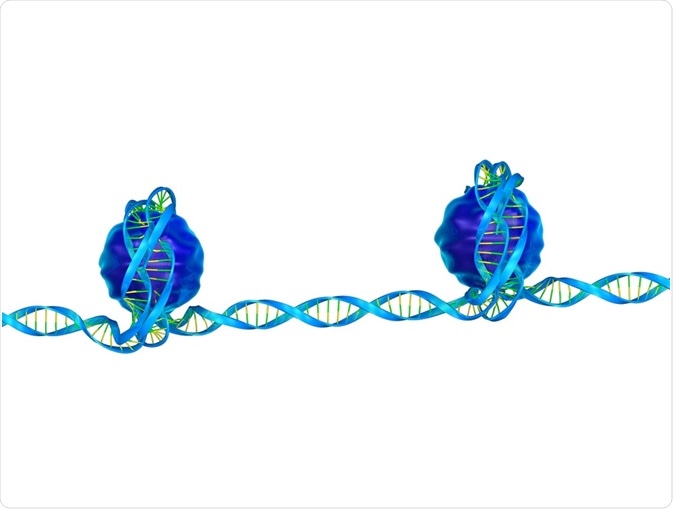Synthetic epigenetics is an upcoming field of biology that involves modifying existing epigenetic pathways by constructing artificial and specific pathways. Synthetic epigenetics, therefore, provides the tools for dissecting epigenetic signaling information and has the potential to explore so far unapproachable domains in both basic and clinical research.
 sciencepics | Shutterstock
sciencepics | Shutterstock
What are the advantages of synthetic epigenetics?
Previous techniques that were used to modify the transcriptional profile of genes include RNA interference (RNAi), gene knock-out, overexpression of certain complementary DNA (cDNA) sequences, or activators and silencers that can be programmed. However, the disadvantages of this method include that they need to be constitutively or continuously expressed to have the desired effect.
However, these changes also lead to irreversible changes within the genome, so there is a need for methods that can maintain the modified epigenetic signal and gene expression for multiple cell divisions – even after the edited epigenetic construct is cleared. This would involve transiently introducing the construct leading to persistent changes in gene expression without any permanent damage.
Bottom-up synthetic epigenetics
In bottom-up synthetic epigenetics, an artificial DNA binding domain is combined with a unique sequence in the desired gene locus. It also has an effector domain that can edit the epigenetic state of the gene locus. Several studies have observed various targeting domains and epigenetic modifiers that can activate or repress specific loci.
Genome targeting proteins
Genome targeting proteins are one of the ways to synthetically regulate the epigenome. For several years it was difficult to design DNA interacting proteins for specific sequences as there were no know DNA recognition code that could connect amino acid residues with corresponding DNA bases. However, with the discovery of programmable DNA binders like zinc finger arrays, TAL effector arrays, and CRISPR/Cas9 systems this is now doable.
Zinc finger arrays
The first example of DNA interaction domains that could bind to proteins were C2H2 (Cys2His2-like fold group) zinc fingers. Naturally occurring and constructed zinc fingers consist of tandem repeated zinc finger arrays where each unit has 30 amino acid residues that are stabilized by zinc ions that are bound to two cysteine and two histidine residues. Custom made zinc fingers consist of three to six individual zinc fingers that can bind to targets of the size that range from 9 to 18 base pairs.
There are two main methods to create engineered zinc fingers: context-dependent modular assembly and bacterial selection systems. In the first method, several smaller zinc finger units are combined into a larger array. In the case of the bacterial selection system, there is an added advantage that the created zinc finger is directly tested in a cellular environment; however, this method is more time consuming and rather tedious.
TAL effector arrays
Transcription activating-like effectors (TALEs) are virulence factors that are isolated from bacterial plant pathogen Xanthomonas and are another class of DNA binding proteins that can be customized. They are a family of tandem repeats of similar 34 amino acids where each repeat can recognize a single base.
As this array has a simple recognition code where each repeat is responsible for recognition of a single base pair and the absence of neighbor effects, TALE arrays have rapidly gained importance. The advantage of TALE and zinc finger include that these constructs have to be remade for specifically designed for each sequence of interest.
CRISPR/Cas9 system
This is the newest tool on the block for modulating the epigenetic system. CRISPR or clustered regularly interspaced short palindromic repeats has been derived from a prokaryotic immune system and confers resistance to genetic elements, including plasmids and bacteriophages.
In nature, foreign DNA is inserted between the CRISPR repeats and this serves as an adaptive memory of foreign exposure. CRISPR systems have been divided into three systems where type II is the simplest, as only one protein component is required. This system has now been used to engineer genome systems is several organisms now.
Sources
- Jurkowski et al. (2015). Synthetic epigenetics—towards intelligent control of epigenetic states and cell identity. Clinical Epigenetics. doi.org/10.1186/s13148-015-0044-x.
- Zuemy Rodriguez-Escamilla, Mario A. Martínez-Núñez, Enrique Merino. (2016). Epigenetics knocks on synthetic biology's door. FEMS Microbiology Letters. doi.org/10.1093/femsle/fnw191
- Yamatsugu, K., et al. (2018) Leading approaches in synthetic epigenetics for novel therapeutic strategies. Curr Opin Chem Biol. doi.org/10.1016/j.cbpa.2018.03.011.
- Jurkowski, T. P., et al. (2015). Synthetic epigenetics—towards intelligent control of epigenetic states and cell identity. Clinical Epigenetics. doi.org/10.1186/s13148-015-0044-x.
Further Reading